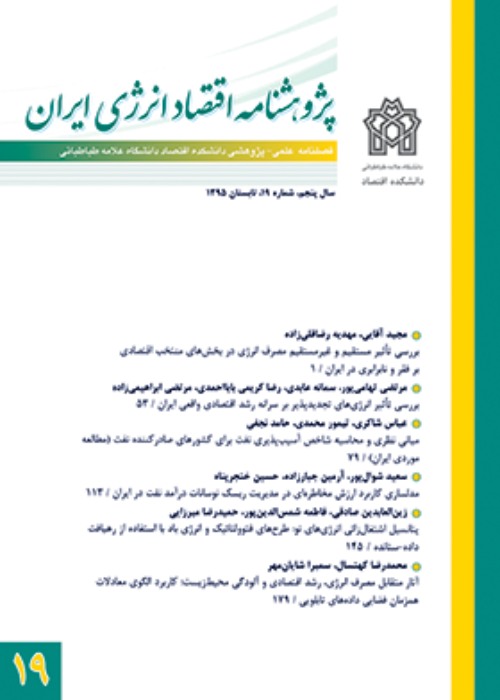Estimating Disaggregated Energy Demand Function for Industrial Subsectors of Iran in Different Climates (Case Study of Textile, Apparel and Leather Products Subsector)
Author(s):
Abstract:
In this study, we estimate the demand for energy in the industrial subsectors of Iran in terms of double-digit ISIC classification using structural time series model (STSM) over the period of 13601981-20091388. As a case study, we alsoAlso, as a case study we estimated the demand for energy in subsection subsectors of textile, apparel and leather products. Furthermore, we try to determine considered the role of different climates in energy demand of the industrial subsectors. Because Since the Targeting of Subsidies Plan was approved by the Iranian parliament at the end of 13892010, so we evaluated the role of this plan on energy demand of industrial subsectors too.
By estimating the demand functions of electricity, natural gas, gas oil and mazut in subsection textile, apparel and leather products, it is found thatThe estimation results of demand for electricity, natural gas, gas oil and mazut fuel oil in three subsectors show that the estimated short-run price elasticities of these energy carriers are inelastic. The estimated long-run price elasticity of electricity is inelastic and long-run price elasticity of natural gas, gas oil and fuel oil mazut are more than unit. The estimated short-run output elasticities of these energy carries are inelastic and long- run output elasticities of electricity, gas oil and fuel oil mazut are inelastic and long- run output elasticitiy of natural gas are elastic. The result shows that the best climate for manufacture in textile sector is mild and humid climate. The results suggest that the nature ofAlso the trend of natural gas and fuel oil mazut demand are not linear and deterministic but stochastic in form andbut for electricity demand isn linear and deterministic. In aAdditionally, the result of evaluating effect of the Targeting of Subsidies Plan shows that the estimated demand for natural gas and fuel oil mazut demand functions can explain the impact of this policy.
By estimating the demand functions of electricity, natural gas, gas oil and mazut in subsection textile, apparel and leather products, it is found thatThe estimation results of demand for electricity, natural gas, gas oil and mazut fuel oil in three subsectors show that the estimated short-run price elasticities of these energy carriers are inelastic. The estimated long-run price elasticity of electricity is inelastic and long-run price elasticity of natural gas, gas oil and fuel oil mazut are more than unit. The estimated short-run output elasticities of these energy carries are inelastic and long- run output elasticities of electricity, gas oil and fuel oil mazut are inelastic and long- run output elasticitiy of natural gas are elastic. The result shows that the best climate for manufacture in textile sector is mild and humid climate. The results suggest that the nature ofAlso the trend of natural gas and fuel oil mazut demand are not linear and deterministic but stochastic in form andbut for electricity demand isn linear and deterministic. In aAdditionally, the result of evaluating effect of the Targeting of Subsidies Plan shows that the estimated demand for natural gas and fuel oil mazut demand functions can explain the impact of this policy.
Keywords:
Language:
Persian
Published:
Journal of Iranian Energy Economics, Volume:5 Issue: 20, 2016
Pages:
115 to 185
magiran.com/p1702691
دانلود و مطالعه متن این مقاله با یکی از روشهای زیر امکان پذیر است:
اشتراک شخصی
با عضویت و پرداخت آنلاین حق اشتراک یکساله به مبلغ 1,390,000ريال میتوانید 70 عنوان مطلب دانلود کنید!
اشتراک سازمانی
به کتابخانه دانشگاه یا محل کار خود پیشنهاد کنید تا اشتراک سازمانی این پایگاه را برای دسترسی نامحدود همه کاربران به متن مطالب تهیه نمایند!
توجه!
- حق عضویت دریافتی صرف حمایت از نشریات عضو و نگهداری، تکمیل و توسعه مگیران میشود.
- پرداخت حق اشتراک و دانلود مقالات اجازه بازنشر آن در سایر رسانههای چاپی و دیجیتال را به کاربر نمیدهد.
In order to view content subscription is required
Personal subscription
Subscribe magiran.com for 70 € euros via PayPal and download 70 articles during a year.
Organization subscription
Please contact us to subscribe your university or library for unlimited access!


